Alice Y. Chen's Blog, page 5
August 16, 2016
Shoes come in pairs, after all.
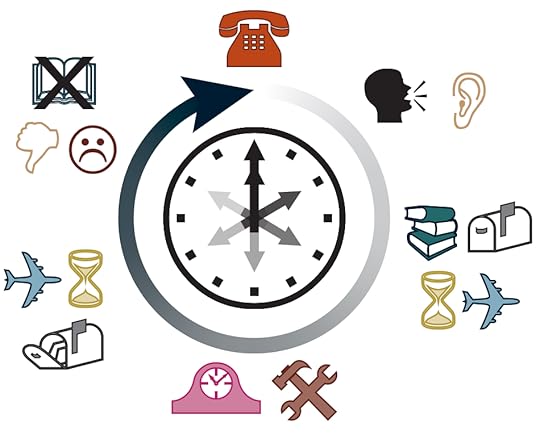
Since it’s hard to illustrate a “call,” I figured another diagram was in order. I admit it, I am addicted to these font symbols.
So, when last we left off, I was about to call Customer Service after receiving my defective copies. I poured all the disappointment into my dejected tone, and the CreateSpace representative was very sympathetic. In fact, she did everything right to soothe me and said everything she needed to, to assure me that this matter would not be taken lightly. That once they received the defective copies back from me, then steps would be performed to 1) investigate what happened, 2) determine the fixes, and then 3) test that the problems had been fixed. All defective copies would be replaced. Sit tight, she said. I got a case number and a reassurance that she, the very same representative, would call me back when she had something to report.
And she did. Which I think is truly extraordinary and worth mentioning. She acknowledged receipt of the defective copies, went through the tracing of which facility it was printed, and alerted them to the issues at hand. She got a test copy made and examined, and once that was complete, a replacement order would be sent to me.
For all the flaws in production and heartache, CreateSpace really does strive to determine the issues and get to a resolution. It’s just a shame that in the end, with the number of calls, back and forth e-mails, and sending back of the defective copies (which they also paid for), I still got a runaround between CreateSpace and Amazon, who pointed fingers at each other at one stage in the process. And then there was the waiting, waiting, and more waiting.
The manufacturing issues were never really resolved. Defective copies still kept coming in the replacement batches that were supposedly checked, one by one, by a real person’s hand.
Eventually, I just dropped it. The deed was done. The only thing I could realistically do at this point was to pull the title and begin again with another POD. This was frankly an unbearable choice for me. I couldn’t start all over. I had further read credible stories that Amazon “sabotages” books printed by PODs other than CreateSpace. And even with the spectre of not knowing how each ordered copy was going to come out, I couldn’t make myself pull the last 6 months’ hard work, determination and anticipation off the shelves.
This is the reason why I still advise all new authors to give the traditional publishing route a go, before self-publishing. I absolutely intend to for my own future books. And if it doesn’t work out, at least I know what I’m getting myself into if I self-publish once again.
Published on August 16, 2016 04:49
August 2, 2016
The sound of the other shoe dropping
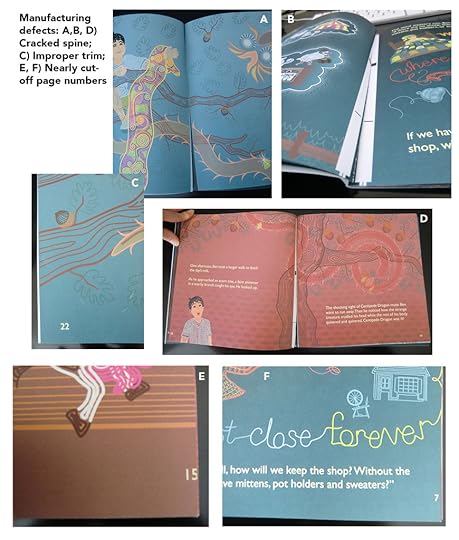
In advance of the two events I will be doing on Sept. 24, I am putting out a call for your help! If you liked my book, I would very much appreciate a review of it on Amazon, regardless of whether or not you have purchased the book. Testimonials shared to my Centipede Dragon Facebook page will also be greatly appreciated!
Now, back to my self-publishing journey. As I relay this next part of the story, I’ll need to take a deep breath.
My first proof proved to be very rewarding. I was foremost relieved that the colors were printing accurately, since the color scheme of the book was so important to its overall look. I felt like perfection was within reach, and so, I spent the next couple of days poring over every square inch of every page, looking for any flaw or any last tiny thing I would want to change or fix. Now, this is worth noting, because I had just been through months of figuring out how to deal not only with gutter-matching, but getting rid of “compressed object streams,” transparency complications, and PDF color shifts and compression problems. The fact that I came back to re-inspect these by now intimately-known 32 pages once again with a fine tooth comb demonstrates how confident I was in being able to achieve a flawless product.
I proceeded to upload, digitally proof, approve, and order my second proof.
And this is where the dream came crashing down.
The first thing I noticed with proof 2 was that the binding seemed a bit strange and puffy. Then I opened the actual book, and the pages began to fall out.
Many of the pages themselves were improperly trimmed. The color of the background should bleed all the way to the edges of the page, yet in this proof, several of the pages had been cut sloppily, as if the page had slipped on the cutting surface, resulting in a white edge that was the bare-part of the page (see C).
And then on some pages the page number was partially cut off!
My heart sank. I heavily picked up the phone to call customer service. Next post, the call.
Published on August 02, 2016 05:08
July 19, 2016
"APPROVE"
I last left you caught in my self-made endless digital proofing cycle. When I finally took the bold step of hitting the “I APPROVE” button, suddenly, excitement surged through my bones.
What was next was the most important step I was about to take. I was on the cusp of ordering the very first print version of my book. The manifestation of years of work. A real book. My book. A REAL version of MY book.
Despite my anxiety I still opted for regular shipping, which required a shipping estimate of around a week. My budget was still a priority, and I think this is important to point out, because it’s easy to get carried away with it all and spend well over what could/should be an affordable venture. If I’d just endured months of grueling revisions and endless tweaks, I reasoned that a few more days of waiting wasn’t going to kill me.
When I finally received the first book, I can’t even begin to describe to you what I experienced when I opened the package to reveal my cover, when I was able to turn the very pages I toiled and agonized over, when I read the words and viewed the images on print...all of it bound in a beautiful, real, book.
I greedily went through it, speeding through the pages rapid-fire for the first few times. Even the colors were bang on. I couldn’t believe my eyes, I couldn’t believe that I was holding MY book. I’m still not sure if it has sunk in to this day, that this book is a real thing.
After a well-deserved few rounds of savoring my book, I reluctantly put my editing hat back on and started scrutinizing it. Let’s face it though, while savoring, the flaws started revealing themselves, so that hat never really came off. I carefully noted each and every single problem I couldn’t live with because NOW was the time to fix it. I was aiming to gang up all these changes to make the next hard copy proof the last (though CreateSpace’s pricing is reasonable, and as I said before, the digital proofing process is exceedingly forgiving.) In fact, the quality of the proof print alone convinced me that I could shoot for perfection.
Having gathered all my thoughts, I bravely dove back into the world of revision. Next post, we’ll get into print proof 2.
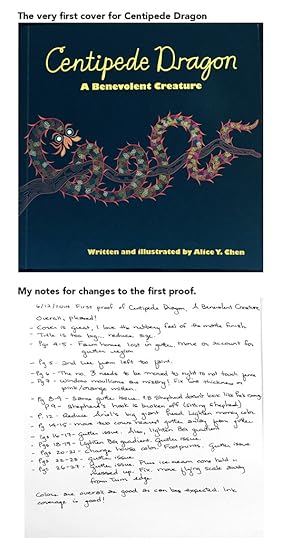
What was next was the most important step I was about to take. I was on the cusp of ordering the very first print version of my book. The manifestation of years of work. A real book. My book. A REAL version of MY book.
Despite my anxiety I still opted for regular shipping, which required a shipping estimate of around a week. My budget was still a priority, and I think this is important to point out, because it’s easy to get carried away with it all and spend well over what could/should be an affordable venture. If I’d just endured months of grueling revisions and endless tweaks, I reasoned that a few more days of waiting wasn’t going to kill me.
When I finally received the first book, I can’t even begin to describe to you what I experienced when I opened the package to reveal my cover, when I was able to turn the very pages I toiled and agonized over, when I read the words and viewed the images on print...all of it bound in a beautiful, real, book.
I greedily went through it, speeding through the pages rapid-fire for the first few times. Even the colors were bang on. I couldn’t believe my eyes, I couldn’t believe that I was holding MY book. I’m still not sure if it has sunk in to this day, that this book is a real thing.
After a well-deserved few rounds of savoring my book, I reluctantly put my editing hat back on and started scrutinizing it. Let’s face it though, while savoring, the flaws started revealing themselves, so that hat never really came off. I carefully noted each and every single problem I couldn’t live with because NOW was the time to fix it. I was aiming to gang up all these changes to make the next hard copy proof the last (though CreateSpace’s pricing is reasonable, and as I said before, the digital proofing process is exceedingly forgiving.) In fact, the quality of the proof print alone convinced me that I could shoot for perfection.
Having gathered all my thoughts, I bravely dove back into the world of revision. Next post, we’ll get into print proof 2.

Published on July 19, 2016 05:13
July 5, 2016
Two events. One Day.

Good Tuesday-after-the-holiday-weekend all! I hope the 4th wasn’t soggy for everyone as it was for us in DC.
Now, are you wondering why WAMU’s radio host Diane Rehm is on this week’s Centipede Dragon post? No, she’s not featuring my book on her show (sad face). No, she’s not reading my book at a local event (sadder face). But, she has one thing in common with Centipede Dragon, in that both she and I will be participants at Northern Virginia’s FALL FOR THE BOOK festival, you guessed it, this coming Fall!
While Ms Rehm is the MAIN headliner for the festival, I will be presenting Centipede Dragon at two kick-off events on Saturday, September 24: in the morning at the Charles Beatley Central Library in Alexandria, VA; and in the afternoon at the Multicultural Book Fair in Reston, VA. Times TBA closer to the date.
Why am I telling you this three months in advance? So you can put it on your calendars NOW. Please come cheer me on and quell my presentation fears! Don’t worry though, this won’t be the last time you hear about these events from me.
Charles Beatley Central Library, 5005 Duke Street, Alexandria, VA 22304
http://www.restoncommunitycenter.com/...
http://fallforthebook.org for more information about the festival.
Published on July 05, 2016 05:31
June 21, 2016
An endless loop
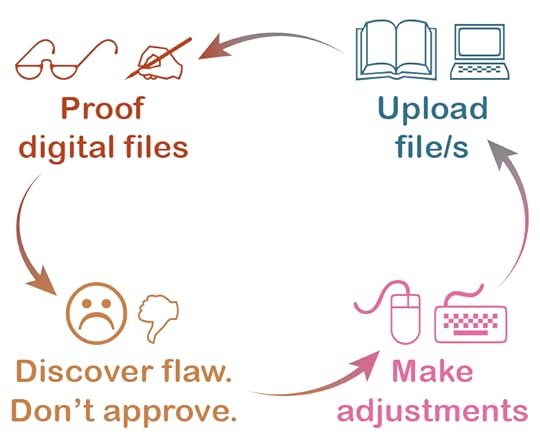
The answer to our last post’s question about what the trim marks actually represent in either proof is: I THINK the yellow arrows in the digital proofer DO mark where the page gets trimmed; whereas in the PDF proof, what we would normally call crop marks, shown as the black right angle lines at each corner, are NOT where the pages get trimmed. Ultimately, neither view really tells you how well your image will line up in the middle. So, it’s guess work, luck, and paying for a hard copy proof that will undeniably show you if you got it right.
At this stage, you might not see issues because you have been living with and loving your work for months, even years. As you close in on the finish, your eyes have adjusted to “Everything looks fine” mode, because you’re so tired of the endless proofing, and always in the back of your mind are all the rejections that compound your uncertainty and faith in your work. And so, when you’re looking at your pages in a different setting, you either see non-existent flaws or you see nothing wrong at all. And here is where I tout another positive point about CreateSpace: the review process is very user-friendly and forgiving. So long as you have not approved your digital proof, you can upload again and again and again. And again. This part of the process is so invaluable to a first-timer, who is trying desperately to learn the process while checking that every mistake is resolved.
For this first-timer, I abused this option shamelessly. There were days where I uploaded viewed, corrected, and uploaded…ALL day.
Over three months had gone by since I had made the decision to self publish. Prior to that, over three months had been spent perfecting a manuscript and illustrations that had already undergone tremendous change and scrutiny since 2012. And so here at this moment in time, I found myself in an endless proofing loop.
Here’s a negative point about CreateSpace: the review process is very user friendly and forgiving.
Published on June 21, 2016 05:36
June 7, 2016
The PLATFORM
At the top of CreateSpace’s advantages is their online review process, which, as I found out later, is sophisticated and fast.
There are two versions of proofing available before you have to order a hard copy proof, shown in the figure: a digital online proofing system and a downloadable PDF proof. Near the top right of the interface are buttons for different ways of viewing: 3D, spread, single page, zoom, and multiple pages. On the right side are little icons of each page, indicating that you can scroll through all your pages.
The online digital proofer simulates your book as a real book. You even get the swooshing sound associated with the page-turning action!
Now let’s look at the PDF proof. Not as much going on, but the pages are presented in spread format, and crop marks show where your pages will be trimmed.
These proofing systems were somewhat confusing for me at first. For instance, in both views, my impression was that there would be a gap in the gutter of my book, rather than a seemless image spread.
Let’ re-visit the issue of gutters. Having never been through this process before, it was confusing to figure out whether I set up the gutters correctly. Take a look at the yellow arrows in the top image, or the virtual proof. The book is open, and the left page looks like it is even buckling upward as a real book page would do. The page is also framed by two sets of dotted lines; this is what the yellow arrows are pointing out. So, my question is, what are these lines representing? Where the page will be trimmed to? Where the pages will physically meet? Answer, next post!
An additional note on CreateSpace: there are no additional fees if you find errors in your proof and need to fix and re-upload. After all, this is why it’s called proofing, so the fact that other platforms charge every time you need to re-upload is frankly unfair. There are simply some problems you can’t see until you reach this stage.

There are two versions of proofing available before you have to order a hard copy proof, shown in the figure: a digital online proofing system and a downloadable PDF proof. Near the top right of the interface are buttons for different ways of viewing: 3D, spread, single page, zoom, and multiple pages. On the right side are little icons of each page, indicating that you can scroll through all your pages.
The online digital proofer simulates your book as a real book. You even get the swooshing sound associated with the page-turning action!
Now let’s look at the PDF proof. Not as much going on, but the pages are presented in spread format, and crop marks show where your pages will be trimmed.
These proofing systems were somewhat confusing for me at first. For instance, in both views, my impression was that there would be a gap in the gutter of my book, rather than a seemless image spread.
Let’ re-visit the issue of gutters. Having never been through this process before, it was confusing to figure out whether I set up the gutters correctly. Take a look at the yellow arrows in the top image, or the virtual proof. The book is open, and the left page looks like it is even buckling upward as a real book page would do. The page is also framed by two sets of dotted lines; this is what the yellow arrows are pointing out. So, my question is, what are these lines representing? Where the page will be trimmed to? Where the pages will physically meet? Answer, next post!
An additional note on CreateSpace: there are no additional fees if you find errors in your proof and need to fix and re-upload. After all, this is why it’s called proofing, so the fact that other platforms charge every time you need to re-upload is frankly unfair. There are simply some problems you can’t see until you reach this stage.

Published on June 07, 2016 05:37
May 24, 2016
Self-publishing choices
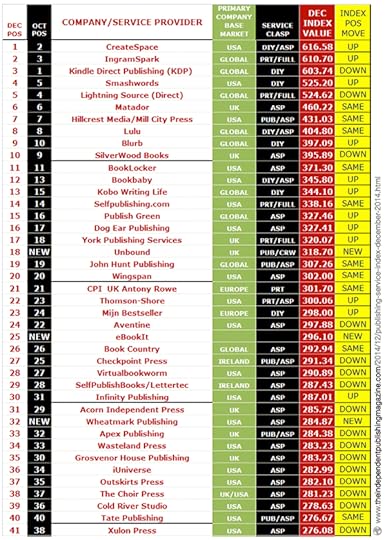
We’ve talked about the number of decisions that are involved in self-publishing prior to getting down to the nitty gritty of producing a book. And I may have already said in a previous post that I chose CreateSpace, an Amazon Company, as my print-on-demand (POD) platform. So why did I choose CreateSpace of the myriad PODs out there, and what is a POD anyway?
My understanding is that in a traditionally published situation, with the first print run of a book, the publisher sets the number of copies to print, and if it sells out, then a new print run of a potentially higher number may follow, because of the demand. If you’re an established author with a good sales history, your next book will likely require a bigger first print-run of your next book, as compared to a first-time author’s first print-run will. This is obviously because that author has a sales history that can be used to gauge how well successive books will sell. Whereas in the first-time author’s case, there is no sales history.
A POD platform is a “print-on-demand” facility, and that’s all it is. It may offer other services parallel to what a traditional publisher would do, but you pay for those services above the costs to print your book. A publisher invests in you, whereas with POD you are putting up all the capital and therefore absorbing all the risk.
Now, when I order 30 copies of Centipede Dragon, the POD will print 30 copies. When someone off the Barnes and Noble or Amazon website orders a single copy, one is printed. The up-side is that copies from a “print-run” will not need to be stored and scheduled for distribution. There’s no inventory, in other words.
As you see from this graphic, taken from the Independent Publishing Magazine’s website, CreateSpace was ranked as the number one POD platform. That, coupled with its being the least expensive-costing option to print, is what my decision was primarily based. Et voila! My choice was made.
Published on May 24, 2016 05:29
May 10, 2016
To digitize or not to digitize
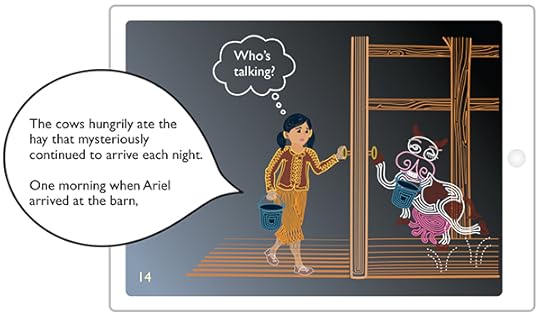
I neglected to mention that I have a new splash page on www.centipededragon.weebly.com website. This is significant because it hints at new characters and gives a sneak peak of BOOK 2, so please visit!
OK, onto the post:
I really wasn’t kidding when I said that a dizzying number of decisions, aside from the actual printing process, have to be made prior to launching a self-published book. For instance, did anyone notice that Centipede Dragon A Benevolent Creature is NOT available as an e-book?
There are numerous success stories to support that selling in e-book format is a good marketing strategy. A low-cost e-book can entice readers who don’t know anything about you or your book, to invest the $1.99 in order to find out who you are. That $1.99 is to the potential reader is a worthy risk, should s/he decide your book is not his/her cup of tea. A major factor in deciding whether you want to sell your book in digital format is frankly the type of book you wrote. Investing in a many-hundreds-paged book is one thing, no matter what the subject. However, investing in a 32-paged, less than 800-worded picture book is an entirely different purchasing decision, based on many other factors aside from general interest.
I could be wrong, but I think people who buy children’s books IN GENERAL want to know what the story is exactly about from beginning to end. They don’t want to introduce a book that lionizes stealing, for example, to their kid, so if there is stealing in the plot, there should be a satisfying resolution that will teach both parent and child. The decision is also influenced by the illustrations. But mainly, people buy children’s books on recommendations, and may be less inclined to just “take a chance.” It is a more careful and curated process. As an adult, we are more ready to take chances on new books and authors, whereas a kid is initially entirely dependent on what parents choose to put in front of them.
This argument was part of the reason why I chose not to simultaneously launch the book in digital format as well. But I always have the option to do so, and might even consider launching it in e-book form now that I’m coming upon two years since its release in July, 2014.
The other part of my argument for resisting the digitization is more abstract. There’s value in a kid getting to physically turn the pages, to flip them back and forth and back and forth, lingering on beloved events, looking back for clues, or re-reading a beloved turn-of-phrase. When a kid deliberately chooses a well-loved story, sits down with it, and just quietly looks through it...that tattered book, with cookie crumbs lodged in the cracked spine and water stains, captures the history of you reading with your kid at bed time and all the discoveries that ensued. Seeing that it could be MY book with the cookie crumbs and water stains over the face of Centipede Dragon, keeps me wedded to print.
Published on May 10, 2016 05:29
April 26, 2016
The value of a centipede dragon
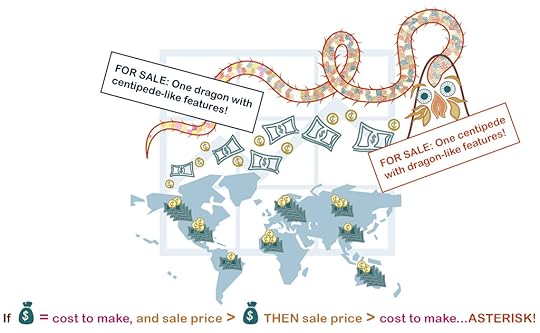
Aside from copyright, distribution, ISBN, metadata, and all the technical production issues we’ve faced thus far, we still have some major points to resolve before we can finally upload, proof and approve our book for self-publication. One big hurdle is to figure out what to set for purchase price. Now, an easy rule, and one that the publishing platform won’t allow you to break anyway, is that the price can’t be less than the cost to make. No-brainer, right?
You absolutely have to cover the cost to print your book, but you also have to consider your own earnings per book. This is your royalty, and like it or not, you are in this game to make some money. After all, you’ve poured blood, sweat, tears, and way more time than you probably can afford in this thus far non-earning pursuit, that it would be better to make some money back.
So, then you might think, OK, if my book costs $9.95 to produce, my price should be higher. Let’s say I’d like to earn about $5.00 per book. So, I’ll set my price at $14.95. Swell!
Well, it’s not swell, because the entire world does not operate on US dollars. Your printed price actually has to account for conversion in all the different currencies that apply to the distribution channels you have selected, and still earn you a minimal profit, no matter how slight, at that one PRINTED price. So in some cases you have to set your printed price much higher than you would like, to accommodate sales everywhere, and still maintain that margin of profit.
Phew, OK, we can do that. But there’s another fly in the ointment (of course).
That is, your competition. Where have they set their prices? If a gorgeous, full-page illustrated picture book that is physically larger and even printed on heavier, artisan paper, is set at a lower price than yours, potential customers will, well, wonder at the value of your book. So, it’s a balancing act, and not at all as straightforward as you would like this decision to be.
So the real question should not be “What is the value of Centipede Dragon, “ but rather, “What is the value of the U.S. Dollar?”
More (YES) issues to tackle, next post!
Published on April 26, 2016 05:29
April 12, 2016
Distribution blues

Remember when we were in school, and the teacher brought in cupcakes for someone’s birthday? The teacher would call upon the birthday boy or girl to distribute the cupcakes, a simple and elegant system indeed.
Books need to be distributed as well. The problem is, instead of 24 cupcakes, there are hundreds of thousands of books that need to be distributed. How does an organization actually get hold of a book? No one has time to keep up with thousands of books that get published every year.
The way the industry has solved this is to set up distribution channels. Retailers subscribe to one or more distribution channel, such that with each channel, they will get a sampling of many publishers’ book lists. Each distribution channel has a selection that may appeal to the larger retailers, or smaller niche retailers. For example, an independent bookstore for example, may decide to sell 60% of books from niche book publishers, but reserve 10% for non-fiction bestsellers, and 30% for the best sellers. Therefore, that bookstore may subscribe to at least 3 distribution channels. A school library may be heavier on stocking books from Capstone, a well-known educational publishing house, but also want to access a publisher specializing in middle-grade chapter fiction books, so its distribution channels will look very different from the first example.
What I’m trying to get at with this blog and this fictitious image (those channels are made-up ones) is that there are a myriad of distribution channels, and that you want your book to be eligible to be included in as many lists as possible. Read that sentence again. There’s a huge difference between “being included” on a list, and “being eligible to be included” on a list. Being included depends upon being discovered AND sought after. But if you’re discovered, yet only 2 out of let’s say 10 channels can include you on their list, you’ve severely hindered your chances of being MORE discovered. So, you want to give your book every allowable chance to be discovered, which means making sure more channels are open to it from the start.
I of course wanted to give as much flexibility as possible to being included on distribution channels, so I opted for the ISBN that was going to give me the most flexibility. Unfortunately, this did not get me the library/academic institution channel. There is a work-around solution that CreateSpace offered, and that was to go ahead and have a separate CreateSpace ISBN assigned. If I did that, I’d now have 2 ISBN numbers, however, I use that 2nd ISBN solely for the academic/library channel, and ignore the first ISBN that would open up ALL the other channels.
I bet you’re wondering at this point why I didn’t select the CreateSpace-assigned FREE ISBN in the first place? After all, it gives me access to ALL distribution channel options, and it was FREE, so why did I opt to pay for an ISBN that limited access to all channels? Answer, next post!
Published on April 12, 2016 05:58



